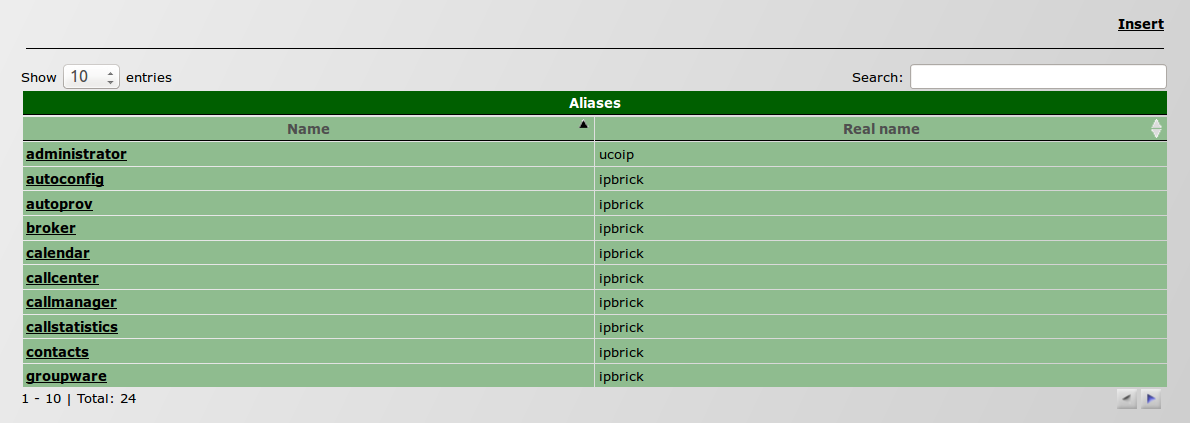Difference between revisions of "How to configure WPAD"
| Line 25: | Line 25: | ||
#* Go to ''Advanced configurations » Support services » DHCP » Subnets » General options''; [[File:subnets.png]] | #* Go to ''Advanced configurations » Support services » DHCP » Subnets » General options''; [[File:subnets.png]] | ||
#* On ''Proxy Auto-configuration'', select ''Yes'' (by default is set up to ''No''). [[File:proxyautoconfiguration.png]] | #* On ''Proxy Auto-configuration'', select ''Yes'' (by default is set up to ''No''). [[File:proxyautoconfiguration.png]] | ||
| − | |||
# Activate WPAD for Proxy. | # Activate WPAD for Proxy. | ||
#* Go to ''IPBrick.C » Proxy » Auto-configuration''; [[File:proxyautoconfiguration3.png]] | #* Go to ''IPBrick.C » Proxy » Auto-configuration''; [[File:proxyautoconfiguration3.png]] | ||
| Line 41: | Line 40: | ||
As a practical example, let's call "srv01" to our internal server and "srv02" to the external one; "srv01" lodges DNS and DHCP services and "srv02" acts as a proxy. | As a practical example, let's call "srv01" to our internal server and "srv02" to the external one; "srv01" lodges DNS and DHCP services and "srv02" acts as a proxy. | ||
| − | + | # To configure our "srv01": | |
| − | + | #* DNS: it's lodged on "srv01" but it has to point to "srv02". | |
| − | * DNS: it's lodged on "srv01" but it has to point to "srv02". | + | #** Go to ''Advanced configurations » Support services » DNS » Domains'' |
| − | + | ||
| − | ** Go to ''Advanced configurations » Support services » DNS » Domains'' | + | |
[[File:DNSdomains.png]] | [[File:DNSdomains.png]] | ||
Revision as of 10:14, 22 September 2015
- * * * THIS PAGE IS UNDER CONSTRUCTION * * *
This How-To will describe the configurations needed to do in a scenario where you have two IPBrick servers:
- One IPBrick is the Intranet server where DHCP and DNS services will run
- One IPBrick is the security server where Proxy service will run
This configuration allows a user to access an Intranet server without needing to use a proxy service as an intermediary and, at the same time, prohibits an external access without a proxy server. The first aspect promotes a better performance and the second one prevents security issues.
Configuration
The following example will explain step by step how to configure a Web Proxy Auto-Discovery.
First scenario
On our first scenario, the aim is to configure WPAD with an IPBrick as an Intranet server, where DHCP and DNS services will run.
In order to do this we have to:
- Activate WPAD for DHCP:
- Activate WPAD for Proxy.
Note: There is no need to configure anything for DNS because it already points to the server in question.
Second scenario
On the second scenario, the aim is to configure WPAD with an IPBrick as a security server, where Proxy server will run.
So, in this case, we have to servers. One of them is an internal server which is connected to our LAN; the other is a communication server that links our LAN to the Internet.
As a practical example, let's call "srv01" to our internal server and "srv02" to the external one; "srv01" lodges DNS and DHCP services and "srv02" acts as a proxy.
- To configure our "srv01":
- DNS: it's lodged on "srv01" but it has to point to "srv02".
- Go to Advanced configurations » Support services » DNS » Domains
- DNS: it's lodged on "srv01" but it has to point to "srv02".
- Select your domain on Forward zone.
- Here it is possible to see several configurations but, for our configuration, search for WPAD on the Aliases table.
- Select WPAD and configure it to your server, "srv02".
- Repeat these steps but this time search for Proxy on Aliases.
- DHCP: activate WPAD.
- Go to Advanced configurations » Support services » DHCP » Subnets » General options;
- On Proxy Auto-configuration, select Yes (by default is set up to No).
Now we have both DNS and DHCP configured on our "srv01", pointing to "srv02".
2) To configure "srv02":
- Proxy: activate WPAD.
- Go to IPBrick.C » Proxy » Auto-configuration;
- On Auto-configuration » Enable Auto-configuration, select Yes (by default is set up to No).








